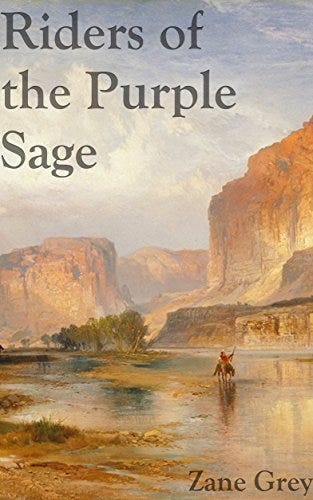Title: Riders of the Purple Sage
Publication Year: 1912
Plot: Told by a master storyteller who, according to critic Russell Nye, “combined adventure, action, violence, crisis, conflict, sentimentalism, and sex in an extremely shrewd mixture,” Riders of the Purple Sage is a classic of the Western genre. It is the story of Lassiter, a gunslinging avenger in black, who shows up in a remote Utah town just in time to save the young and beautiful rancher Jane Withersteen from having to marry a Mormon elder against her will. Lassiter is on his own quest, one that ends when he discovers a secret grave on Jane’s grounds.
Miscellaneous: During World War II the novel was rejected for publication as an Armed Services Editions paperback provided to US servicemen due to perceived bias against Mormonism. There are also 5 film adaptations.
It feels great to be having a fresh, new book club again. We’re at a new facility and the readers are energized and excited to be meeting again. Since this is UPEP’s first offering in the new state prison, we are meeting with people who have taken classes from us before. In future clubs, we’ll recruit new readers, but for now, we figured it’d be easier to go with what we know while we figure out the new facility and system.
Anyway, for our first book, we read Riders of the Purple Sage. The group discussion leader had read it decades ago and was excited to lead a discussion about it. It seems like all but one of the group really enjoyed the book. The lone dissenter said, “I don’t particularly care for westerns and I don’t read romance.” Well, if those two things don’t do it for you, this book might not be for you! Everyone else commented on the wonderful blend of adventure, romance, and good writing that they found in Zane Grey’s book.
This book was especially interesting to read in the Utah State Prison since it takes place in Utah and many of the characters are members of The Church of Jesus Christ of Latter-day Saints, or Mormons as they are more commonly known. We talked about some of our favorite quotes throughout the book, and perhaps a little jokingly, one reader said his favorite one was on page 10: “To hell with your Mormon law!” He said, “How many times have I said that in my life?” It led us to discussions of the role that the LDS faith plays in the lives of the characters and how it’s portrayed. In regards to this, one reader pointed out a quote on page 131 that says something along the lines of Jane being “false to [her] womanhood” but true to her Mormonism.
This reader commented how Jane exhibits a lot of the good qualities of good Mormon people. “She’s the essence of giving. She gives people what they need, regardless of who they are or what they’ve done…she is a great example of the best Mormons have to offer.” Elder Tull, on the otherhand, is exclusive, demanding, violent, and judgemental. He uses an “unrighteous dominion” to exact his will on others. And when he doesn’t get his way, he isn’t happy about it. This bled into a discussion of different anecdotes of how Mormonism has touched the group’s lives, and we had to get things back on track.
We speculated on how this book may or may not have informed people about the Mormon faith when it was published in 1912. What did people know about Utah and the religious group that sought refuge there? Did this book make people fearful of them? Curious about them? We thought it’d be interesting to read contemporary reviews.
We talked about who we thought the heroes of the novel are. Jane and Lassiter are the characters that came to mind first. Jane is kind and wants to help everyone. Lassiter serves no creed and sees things a bit more plainly in terms of good and evil. Tull was a villain, and the Masked Rider was mysterious for a bit of the novel.
Every reader commented on how transportative this novel was. They were swept up in the setting, the characters, and felt it was a great escape from their setting. We all agreed that Zane Grey can write! He obviously spent a lot of time outdoors and in the West. It pays off big time in this novel. We talked about why this book and Western novels were so popular in the first half of the 21st century. With America still growing and expanding, it was a way for people to experience the West. If you lived in New York City in 1912, it was probably difficult to imagine living on a ranch with nobody within miles of you. There is something alluring about life being lived off of the land. The expansiveness of the West being large enough for anyone to hold their dreams there.
This was a great, if not obligatory first book to kick off this book club. Everyone had positive things to say about it. Let us know if you’ve read it and what you thought!
Next week, we’re reading Hondo by Louis L’Amour. Hope you’re reading something good.
Until then,
E.
Here are some links if you’d like to read or listen to the book:





I never particularly cared for the descriptive parts of books even if they are written well. I don’t know why. To me it’s just a wall of text that gets in the way of the plot. A very notable exception to this is this book. I will skim plot points in the story to get to Grey’s beautiful descriptions of the land. His descriptions is the best part of the book.